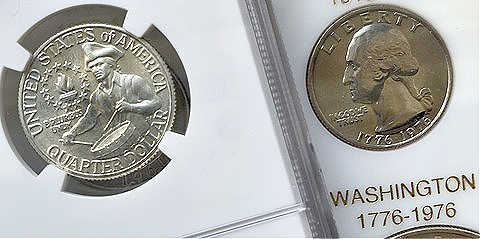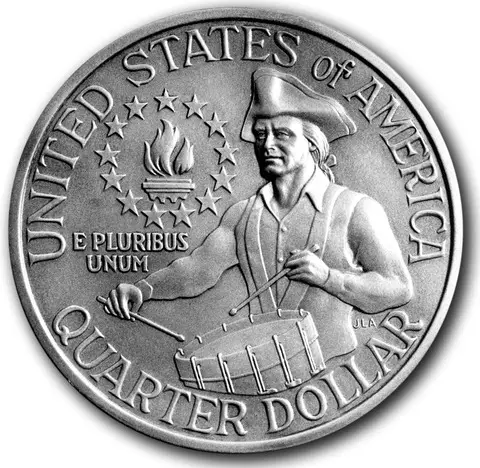Have you found a 1776-1976 drummer boy quarter in your pocket change?
It surely looks different than most other quarters you’re bound to encounter in circulation!

- Why did the United States Mint make drummer boy quarters?
- Why does the drummer boy quarter have the 1776-1976 date?
- What do the letters “JLA” mean on drummer boy quarters?
- How many drummer boy quarters were made?
- Are there any drummer boy quarter errors worth looking for?
- What else makes these Bicentennial quarters different from regular Washington quarters?
There’s a lot to unpack with these 1976 quarters, so let’s dive right into the fascinating story behind the drummer boy quarter…
History Of The Drummer Boy Quarter
The reason for striking a drummer boy quarter with the 1776-1976 date originates in the early 1970s — when the United States Congress, Treasury, and U.S. Mint began debating ways to use coins in celebrating the nation’s 200th birthday, which was to occur on July 4, 1976.
The goal of creating special coins to honor the United States Bicentennial is traced back to the Coins and Medals Advisory Committee of the American Revolutionary Bicentennial Commission’s Coins and Medals Advisory Committee — which in 1970 proposed a commemorative Bicentennial half dollar.
Congressional proposals for the coin in 1971 and 1972 failed to pass. The reason for this really had less to do with the patriotic merits of idea itself and more to do with the fact that commemorative coins (which the United States first minted in 1892 and produced on and off for decades) had become somewhat controversial by the early 1970s.
Many of the commemorative coins of the 1930s were connected to private organizations that misappropriated funds raised from the sales of these special coins. In multiple instances, the anniversaries or events memorialized on some of the coins were thought by some to be too insignificant to warrant being celebrated on a coin. The United States commemorative coin program had left a bad taste in the mouths of many officials, who brought an end to the program in 1954.
By the early 1970s, it was pretty much accepted fact that Congress and the powers that be at the U.S. Mint weren’t reviving the U.S. commemorative coin program.
U.S. Mint Director Mary Brooks was opposed to the idea of making Bicentennial commemoratives out of the six then-circulating coins (cent, nickel, dime, quarter, half dollar, and dollar coin) as some political officials called for. However, she did consider these two ideas:
- Minting 1976 coins with a special “1776-1976” dual date.
- Striking a special non-circulating Bicentennial coin, such as a gold coin.
Eventually, Brooks warmed to the idea of circulating Bicentennial coins and coaxed Treasury Secretary George Shultz to get behind the idea, too.
By January 1973, Congressmen were introducing formal bills pitching new commemorative coins:
- One bill called for commemorative half dollars and dollar coins.
- Another bill supported a $25 gold coin.
Over the next several months, the Treasury endorsed the overarching concept of Bicentennial coinage. Likewise, Brooks posed ideas to help make the striking of Bicentennial coins more feasible — including expanding the production of U.S. coins to the West Point Mint in New York.
By June 1973, Brooks was proposing that a Bicentennial quarter also be made, and this was included in a bill that authorized Bicentennial quarters, half dollars, and dollar coins. The legislation passed muster of the Senate on July 13, 1973, with further debate in September of that year that refined some details of the bill. Among the stipulations were that the Bicentennial coins:
- Carry a 1776-1976 date on the obverse (“heads side”)
- Show special patriotic designs on the reverse (“tails side”)
- Be struck between July 4, 1975, and January 1, 1977
- Come in special 40% silver versions for collectors
The revised version of the Bicentennial coin bill passed the House and Senate on October 4, 1973, and was signed into law by President Richard Nixon on October 18, 1973.
With a law in place to permit the striking of 1776-1976 Bicentennial coins, the next thing the U.S. Mint needed was designs for the new coins!
The Department of the Treasury opened a special competition on October 23, 1973 — seeking a new reverse design for the quarter, half dollar, and dollar coin. The design competition was open to all U.S. citizens and asked people to submit one drawing or a photograph of a plaster model that included the design along with the legends UNITED STATES OF AMERICA, E PLURIBUS UNUM, and the denomination of the coin. A panel of judges would advise Shultz on which design to use for each coin.
The U.S. Mint received 884 entries by the final January 9, 1974 deadline. The prize was $5,000 for each successful entry.
These 3 designs were selected for the Bicentennial coins:
- The colonial drummer boy for the Bicentennial quarter coin
- Philadelphia’s Independence Hall for the Bicentennial half dollar coin
- The Liberty Bell superimposed on the Moon for the Bicentennial dollar coin

Drummer Boy Quarter JLA Meaning
Notice that little “JLA” on the drummer boy quarter reverse pictured above?
I know a lot of people are looking for more information about the drummer boy quarter JLA and what this is supposed to mean.
JLA are the initials of Jack L. Ahr, the designer of the drummer boy quarter.
The successful entry in the Bicentennial coin competition of 1973-74 would live into eternity as the calling card for Ahr, a highly accomplished artist.
Ahr was born in 1931 and served in the Korean War. He studied art at Bowling Green State University, continued his studies at the John Herron Institute of Art located in Indianapolis, Indiana, and went on to the American Academy of Art in Chicago. He was employed as an artist at various companies before opening his own art and design business in 1972.
Submitting the colonial drummer boy design for the quarter, Ahr found himself among two other successful Bicentennial coin designers:
- Seth Huntington designed the Independence Hall motif for the 1776-1976 half dollar.
- Dennis Williams designed the Liberty Bell superimposed upon the Moon for the 1776-1976 dollar.
Ahr’s drummer boy quarter design was slightly modified to help make the drum appear more realistic, enhance the face of the drummer, and alter the font of the lettering.
More than 1.6 billion drummer boy quarters were struck — with the vast majority released into circulation and several million offered to coin collectors in special Bicentennial coin sets.
Jack L. Ahr passed away at the age of 86 on November 19, 2017. His obituary prominently mentions that he designed the 1776-1976 Bicentennial quarter.
Rare Drummer Boy Quarter Errors
Here are three valuable 1776-1976 drummer boy quarter errors that are worth looking for in your spare change…
#1 – Drummer Boy Quarter Doubled Die Error
It seems like everyone wants to know about the 1976 double die quarter (or doubled die, as it’s correctly termed).
There are a few kinds of 1776-1976 drummer boy doubled die quarters that are known to exist:
- One of the most prominent kinds involves doubling of the word “LIBERTY” on the obverse.
- Others exhibit light doubling elsewhere on the coin — including in the “JLA” and other inscriptions.
#2 – Drummer Boy Quarter Smooth Edge Error
This is another thing people frequently ask about — 1976 quarters with smooth edge or no ridges or lines on edge.
The smooth edge on a 1976 drummer boy quarter is most often caused by heavy wear — from frequent and repeated use in vending machines and the like. If your drummer boy quarter is a normal thickness and diameter but has a smooth edge, then it’s most likely not an error coin — the smooth edge is just caused by intense wear.
There is also a type of novelty known as a dryer coin, in which the edges are smooth due to the edge of the coin being rolled inward by spinning around under centrifugal force inside a clothes dryer. Similar results can be achieved by a more deliberate process known as spooning, where the edge of the coin is pushed inward by a blunt object (yes, people wile away their free time doing stuff like this to coins).
However… if your 1776-1976 drummer boy quarter has a smooth edge AND is wider and flatter than normal, then it could be a broadstrike error!
#3 – Drummer Boy Quarter Off-Center Error
If you find a drummer boy quarter that appears to have been struck not exactly on square, it could be an off-center error.
These are cool coins that are created (by accident) when the coin isn’t squarely seated between the two dies on the press.
The most valuable 1776-1976 drummer boy off-center quarter error would show only about 50% of its design yet reveal a complete date on the coin.
Drummer Boy Quarter Value
Did you know that some 1776-1976 quarters are worth hundreds or even thousands of dollars?
Find out how much your 1776 drummer boy quarter is worth here.
It just goes to show that you really can land real treasure and big money in pocket change!




